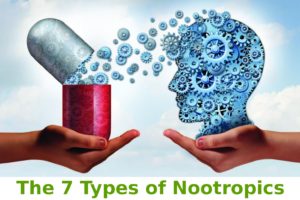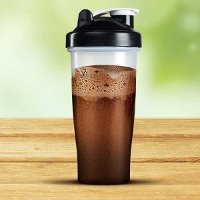If you have any interest in nootropics, one of the first steps you should take is developing a better understand of each type. After all, with seven to choose from you must understand what each does to select the right choice for your specific needs.
Each type of nootropic stands distinct from the rest and while some have been around for decades since the initial discovery of nootropics, others are relatively new and were released only years ago.
The seven types of nootropics include: Natural/Herbal, Racetams, Cholines, Peptides, Vitamin B Derivatives, Ampakines, and Smart Drugs. Below, we’re discussing each, including their unique properties and benefits, to ensure you’re equipped with the knowledge you need to construct your own ideal stack. See also: The Top 5 Benefits of Nootropics.

NooCube ™ – Increase Your Brain function and power
| The Nootropics’ Types | Description | |
|---|---|---|
Natural/Herbal Nootropics | Natural/herbal nootropics are plant-based nootropics that offer a host of natural benefits. Most notably, they increase brain health and functioning. Being plant-based, many of these ingredients have been used for thousands of years; it’s just that people didn’t know at the time they were using nootropics! Many of these ingredients are also backed by a number of studies showing their positive effects on brain health. Because they are natural, they are incredibly safe, giving peace of mind to those who are apprehensive to try nootropics for the first time. | |
| Popular Options: | Valorcine, Bacopi Monneri[1][2][3][4][5], and Ginkgo Biloba[6][7][8][9][10] | |
Racetams | If one type of nootropic were most popular, it would be racetams. After all, the first ever nootropic synthesized by Dr. Giurgea was Piracetam, one of the most popular nootropics to this day. All racetams share a similar structure and are composed of hydrogen, oxygen, and nitrogen. Each is known to improve core cognitive functioning such as memory and focus while simultaneously boosting mood and improving energy levels. Racetams are also known to be neuroprotective, meaning they increase cell regrowth while protecting against deterioration. | |
| Popular Options: | Piracetam[11][12], Pramiracetam[13], and Oxiracetam[14] | |
Cholines | The majority of people are choline deficient, though it is a water-soluble nutrient found naturally in the body. But because it is essential for both brain functioning and health, supplementing your body with the substance is essential. Although choline nootropics offer benefits such as memory and learning improvements, they are typically taken with other nootropics, specifically racetams. When combined, racetams stimulate acetylcholine receptor sites, allowing for the synthesis of choline nootropics and amplifying their results. Each choline nootropic offers different benefits. For example, Citicoline increases dopamine levels in the brain while Alpha GPC increases memory and learning, even amongst Alzheimer’s patients. Learning more about each is important prior to making a purchase. | |
| Popular Options: | Citicoline[15][16], Centrophenoxine[17][18], and Alpha GPC[19] | |
Peptides | Peptides are similar to racetams, though the most popular option, Noopept, is widely thought to be much more potent than Piracetam. These nootropics offer benefits similar to racetams as well by improving learning capabilities, energy, alertness, memory, and motivation. As Dr. Skondia required of nootropics, peptides are well-known for their ability to cross the blood-brain barrier. As such, you can take less while enjoying the same results you expect. Specifically, Noopept stimulates the release of Nerve Growth Factor, a protein essential for the growth and maintenance of neurons and nerve cells throughout the brain and body. By stimulating AMPA and NDMA receptors, this nootropic functions similarly to racetams and ampakines, promising great results for users. | |
| Popular Options: | Noopept[20] | |
Vitamin B Derivatives | Although a small category, Vitamin B derivatives form another major type of nootropics and are used to combat fatigue while increasing both energy and alertness. Vitamin B derivatives were first synthesized in Japan because the population was deficient in Thiamine, or Vitamin B1. Since then, it has become more popularized and is also used to improve memory by affecting choline, glutamate, and dopamine levels in the brain. This category of nootropics is well-known for its positive effects on both Alzheimer’s patients and schizophrenics, giving it a more mainstream use. | |
| Popular Options: | Sulbutiamine[21][22] | |
Ampakines | As one of the newest forms of nootropics, ampakines are also amongst the most potent options available. Like peptides, ampakines stimulate AMPA and NDMA receptors, thereby increasing glutamate levels in the blood. Glutamate is a neurotransmitter that greatly affects synaptic plasticity, making it essential for proper learning and memory. Ampakines are often used as alternatives to stimulants such as Ritalin or something as mainstream as caffeine. However, they aren’t associated with the same negative side effects such as anxiety, insomnia, and a general feeling of restlessness. Because there is little research on ampakines at the moment and they are relatively new, it’s best to stick with popular options if you want to add these nootropics to your stack. However, they are generally more expensive than other available options. | |
| Popular Options: | Sunifiram[23][24][25] and Unifiram[24][25] | |
Smart Drugs | Smart drugs are typically not nootropics. In fact, most of the substances that are classified as smart drugs do not pass the standards set by Dr.’s Giurgea or Skandia upon the initial discovery of nootropics. Instead, smart drugs are amphetamine-based, making them stimulants (for example, Adderall). However, there are some drugs like Modafinil that is thought of as a nootropic because it increases levels of the neurotransmitter hypocretin, increasing energy, alertness, and motivation. Several smart drugs, including Modafinil, are heavily regulated and restricted in the United States. As such, most users turn to alternatives like Adrafinil as an alternative because it converts into Modafinil upon digestion. | |
| Popular Options: | Adderil, Modafinil[26][27], and Adrafinil[28] | |
Educate Yourself to Choose the Best Nootropics for Your Needs

BrainSense ™ – The secret to higher intelligence? (hint, it’s not IQ)
Whether your goal is to increase synaptic plasticity with ampakines, improve memory and energy with racetams, or take a bet on smart drugs, there is a nootropic for everyone.
By learning more about each of the types of nootropics above, you can do your part to ensure you’re creating a stack that will promise the benefits you want. With the right combination, you’ll have the energy, focus, and drive to take on every day, all while improving your long-term cognitive health in the process.

BrainPill ™ – Boost Your Brainpower with Brain Pill!
Copywrite
This is an open access article distributed under the Creative Commons Attribution License, which permits unrestricted use, distribution, and reproduction in any medium, provided the original work is properly cited.
References & External links
- Singh, H. K., and B. N. Dhawan. “Neuropsychopharmacological effects of the Ayurvedic nootropic Bacopa monniera Linn.(Brahmi).” Indian Journal of Pharmacology 29.5 (1997): 359. “Bacopa monniera Linn. (Brahmi) has been used since times immemorial as nerve tonic for Improvement of memory“
- Stough, Con, et al. “The chronic effects of an extract of Bacopa monniera (Brahmi) on cognitive function in healthy human subjects.” Psychopharmacology 156.4 (2001): 481-484. “These findings suggest that B. monniera may improve higher order cognitive processes that are critically dependent on the input of information from our environment such as learning and memory.“
- Tripathi, Yamini B., et al. “Bacopa monniera Linn. as an antioxidant: mechanism of action.” Indian Journal of Experimental Biology 34.6 (1996): 523-526. “Bacopa monniera, Linn. (Brahmi: Scrophulariaceae) an Ayurvedic medicine is clinically used for memory enhancing, epilepsy, insomnia and as mild sedative.“
- Roodenrys, Steven, et al. “Chronic effects of Brahmi (Bacopa monnieri) on human memory.” Neuropsychopharmacology 27.2 (2002): 279-281. “The results show a significant effect of the Brahmi on a test for the retention of new information.“
- Russo, A., and F. Borrelli. “Bacopa monniera, a reputed nootropic plant: an overview.” Phytomedicine 12.4 (2005): 305-317. “The plant, plant extract and isolated bacosides (the major active principles) have been extensively investigated in several laboratories for their neuropharmacological effects and a number of reports are available confirming their nootropic action.“
- Le Bars, Pierre L., et al. “A placebo-controlled, double-blind, randomized trial of an extract of Ginkgo biloba for dementia.” Jama 278.16 (1997): 1327-1332.
- Kleijnen, Jos, and Paul Knipschild. “Ginkgo biloba.” The Lancet 340.8828 (1992): 1136-1139.
- Oyama, Yasuo, et al. “Ginkgo biloba extract protects brain neurons against oxidative stress induced by hydrogen peroxide.” Brain research 712.2 (1996): 349-352.
- Semlitsch, Heribert V., et al. “Cognitive psychophysiology in nootropic drug research: effects of Ginkgo biloba on event-related potentials (P300) in age-associated memory impairment.” Pharmacopsychiatry 28.04 (1995): 134-142. “Extracts from the leaves of Ginkgo biloba have been suggested to be useful in the treatment of various symptoms of impaired brain functions in advanced age.“
- Stough, Con, et al. “Neuropsychological changes after 30-day Ginkgo biloba administration in healthy participants.” International Journal of Neuropsychopharmacology 4.2 (2001): 131-134. “Ginkgo biloba extract (EGb) from the world’s oldest living tree has been reputed to ameliorate cognitive decline in the elderly and slow cognitive deterioration in patients with dementia of the Alzheimer’s type. EGb remains as one of the most popular plant extracts to alleviate symptoms associated with a range of cognitive disorders such as Alzheimer’s disease, vascular dementia and age-related amnesic conditions.“
- Gouliaev, Alex Haahr, and Alexander Senning. “Piracetam and other structurally related nootropics.” Brain research reviews 19.2 (1994): 180-222. “Nearly three decades have now passed since the discovery of the piracetam-like nootropics, compounds which exhibit cognition-enhancing properties, but for which no commonly accepted mechanism of action has been established. This review covers clinical, pharmacokinetic, biochemical and behavioural results presented in the literature from 1965 through 1992 (407 references) of piracetam, oxiracetam, pramiracetam, etiracetam, nefiracetam, aniracetam and rolziracetam and their structural analogues.“
- Piercey, M. F., et al. “Reversal of scopolamine-induced amnesia and alterations in energy metabolism by the nootropic piracetam: implications regarding identification of brain structures involved in consolidation of memory traces.” Brain research 424.1 (1987): 1-9.
- Claus, J. J., et al. “Nootropic drugs in Alzheimer’s disease Symptomatic treatment with pramiracetam.” Neurology 41.4 (1991): 570-570.
- Mondadori, Cesare, Hans-Jörg Möbius, and Jürgen Borkowski. “The GABA B receptor antagonist CGP 36 742 and the nootropic oxiracetam facilitate the formation of long-term memory.” Behavioural brain research 77.1 (1996): 223-225. “The memory-enhancing effects of a single treatment with the GABAB antagonist CGP 36 742 (10 mg/kg) or the nootropic agent oxiracetam (100 mg/kg) given immediately after a learning experience (‘post-trial’) remain detectable for at least 4 months thereafter. This indicates that in all probability these substances facilitate the formation of the long-term memory trace.“
- Alvarez, X. Anton, et al. “Citicoline improves memory performance in elderly subjects.” Methods and findings in experimental and clinical pharmacology 19.3 (1997): 201-210. “According to the present results, showing that citicoline improves memory performance in elderly subjects, we concluded that this molecule is suitable for the treatment of memory deficits in old people. “
- Grieb, P. “Citicoline: a food that may improve memory.” Med. Sci. Rev 2 (2015): 67-72. “Citicoline supplementation may be useful for subjects with memory disorders of mild-to-moderate intensity, those undergoing neurorehabilitation following brain strokes, and for healthy subjects facing requirements for enhanced attention and mental effort.“
- Krapivin, S. V., and T. A. Voronina. “Comparative neurophysiological study of the nootropic drugs piracetam and centrophenoxine.” Farmakologiia i toksikologiia 50.6 (1986): 17-20.
- Zs-Nagy, Imre. “On the role of intracellular physicochemistry in quantitative gene expression during aging and the effect of centrophenoxine. A review.” Archives of gerontology and geriatrics 9.3 (1988): 215-229.
- Lopez, C. M., et al. “Effect of a new cognition enhancer, alpha-glycerylphosphorylcholine, on scopolamine-induced amnesia and brain acetylcholine.” Pharmacology Biochemistry and Behavior 39.4 (1991): 835-840.
- Ostrovskaya, Rita U., et al. “The nootropic and neuroprotective proline-containing dipeptide noopept restores spatial memory and increases immunoreactivity to amyloid in an Alzheimer’s disease model.” Journal of psychopharmacology 21.6 (2007): 611-619.
- Sulbutiamine is a synthetic molecule which consists of two Thiamine (Vitamin B1) molecules bound together by a sulfur group, and appears to be somewhat useful in alleviating fatigue; especially that associated with infection.
- Sulbutiamine (brand name: Arcalion) is a synthetic derivative of thiamine (vitamin B1). As a dimer of two modified thiamine molecules, it is a lipophilic compound that crosses the blood–brain barrier more readily than thiamine and increases the levels of thiamine and thiamine phosphate esters in the brain. https://en.wikipedia.org/wiki/Sulbutiamine.
- Ghelardini, C., et al. “DM235 (sunifiram): a novel nootropic with potential as a cognitive enhancer.” Naunyn-Schmiedeberg’s archives of pharmacology 365.6 (2002): 419-426.
- Scapecchi, Serena, et al. “Structure–activity relationship studies on unifiram (DM232) and sunifiram (DM235), two novel and potent cognition enhancing drugs.” Bioorganic & medicinal chemistry 12.1 (2004): 71-85.
- Romanelli, M. N., et al. “Pharmacological characterization of DM232 (unifiram) and DM235 (sunifiram), new potent cognition enhancers.” CNS drug reviews 12.1 (2006): 39-52.
- Schmitt, Kyle C., and Maarten EA Reith. “The atypical stimulant and nootropic modafinil interacts with the dopamine transporter in a different manner than classical cocaine-like inhibitors.” PloS one 6.10 (2011): e25790.
- Neale, Chris, et al. “Cognitive effects of two nutraceuticals Ginseng and Bacopa benchmarked against modafinil: a review and comparison of effect sizes.” British journal of clinical pharmacology 75.3 (2013): 728-737.
- Milgram, Norton W., Heather Callahan, and Christina Siwak. “Adrafinil: a novel vigilance promoting agent.” CNS Drug Reviews 5.3 (1999): 193-212.
- Biloba, Ginkgo. “Herbal remedies: adverse effects and drug interactions.” Am. Fam. Physician 59.5 (1999): 1239-1244.
- Das, Amitava, et al. “A comparative study in rodents of standardized extracts of Bacopa monniera and Ginkgo biloba: anticholinesterase and cognitive enhancing activities.” Pharmacology Biochemistry and Behavior 73.4 (2002): 893-900. “Bacopa monniera and Ginkgo biloba are well-known cognitive enhancers in Indian and Chinese traditional medicine systems“











Comments
“The 7 Types of Nootropics”